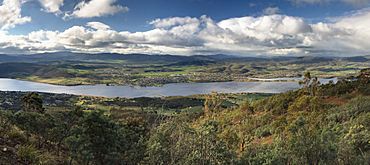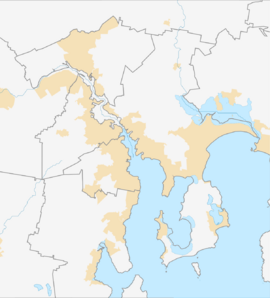Brighton, Tasmania facts for kids
Quick facts for kids BrightonTasmania |
|||||||||
|---|---|---|---|---|---|---|---|---|---|

Brighton is located in the rear left behind Bridgewater, Gagebrook
|
|||||||||
| Population | 4,983 (2021 census) | ||||||||
| Postcode(s) | 7030 | ||||||||
| Location |
|
||||||||
| LGA(s) | Brighton, Southern Midlands | ||||||||
| State electorate(s) | Lyons | ||||||||
| Federal Division(s) | Lyons | ||||||||
|
|||||||||
Brighton is a suburb in Tasmania, Australia. It's about 27 kilometers (17 miles) north of Hobart. You can find it along the Midland Highway. It sits between the towns of Pontville and Bridgewater.
In 2021, about 4,983 people lived in Brighton.
Contents
History of Brighton
Before Europeans settled in Tasmania, the Brighton area was home to the Moomairremener people. They were a group from the Oyster Bay Tribe.
Brighton Barracks and Early Services
From 1826, Brighton was home to the Brighton Barracks. This was a place where soldiers lived and trained. It was used for many years until the early 2000s. Then, the land was sold off for new homes and buildings.
Brighton also had a Post Office that opened in 1832. This office later changed its name to Pontville in 1895 and closed in 1973. The current Brighton Post Office opened in 1964.
Railway Line and Recent Events
A railway line once ran from Brighton to Apsley. It was 42 kilometers long and started in 1891. Passenger trains stopped running in 1927. By 1947, trucks replaced the goods service, and the railway line was removed.
More recently, Brighton helped people who needed a safe place to stay. It provided emergency housing for those escaping difficult situations in eastern Europe.
In January 2003, the area around Brighton faced large bushfires. These fires came very close to the town.
Future Development
Brighton is expected to grow with more light industrial businesses. This means more factories and workshops. The area is good for this because it has both road and rail connections. This includes the new Brighton Transport Hub.
Climate in Brighton
Brighton has a climate with warm summers and cool winters. The average high temperature in January is about 24.5°C (76.1°F). In July, the average high is around 13.2°C (55.8°F).
The average low temperature in January is about 11.7°C (53.1°F). In July, it drops to about 3.5°C (38.3°F).
Brighton doesn't get a lot of rain, about 479.3 mm (18.9 inches) each year. However, the rain is spread out over about 153 days. This means it rains a little bit often, rather than a lot all at once.
The hottest day ever recorded was 41.1°C (106.0°F) in January 2013. The coldest was -3.5°C (25.7°F) in September 2013.
| Climate data for Brighton (42º41'24"S, 147º25'48"E, 45 m AMSL) (2000-2024 normals and extremes) | |||||||||||||
|---|---|---|---|---|---|---|---|---|---|---|---|---|---|
| Month | Jan | Feb | Mar | Apr | May | Jun | Jul | Aug | Sep | Oct | Nov | Dec | Year |
| Record high °C (°F) | 41.1 (106.0) |
39.3 (102.7) |
38.1 (100.6) |
32.0 (89.6) |
25.3 (77.5) |
20.0 (68.0) |
19.8 (67.6) |
25.0 (77.0) |
28.0 (82.4) |
34.3 (93.7) |
38.3 (100.9) |
40.6 (105.1) |
41.1 (106.0) |
| Mean daily maximum °C (°F) | 24.5 (76.1) |
23.9 (75.0) |
22.3 (72.1) |
19.0 (66.2) |
15.9 (60.6) |
13.6 (56.5) |
13.2 (55.8) |
14.2 (57.6) |
16.3 (61.3) |
18.2 (64.8) |
20.4 (68.7) |
22.7 (72.9) |
18.7 (65.6) |
| Mean daily minimum °C (°F) | 11.7 (53.1) |
11.2 (52.2) |
10.1 (50.2) |
7.5 (45.5) |
5.7 (42.3) |
3.9 (39.0) |
3.5 (38.3) |
3.9 (39.0) |
5.3 (41.5) |
6.6 (43.9) |
8.6 (47.5) |
10.0 (50.0) |
7.3 (45.2) |
| Record low °C (°F) | 2.5 (36.5) |
2.0 (35.6) |
0.0 (32.0) |
−1.7 (28.9) |
−2.9 (26.8) |
−3.2 (26.2) |
−3.2 (26.2) |
−3.1 (26.4) |
−3.5 (25.7) |
−3.0 (26.6) |
−0.3 (31.5) |
1.4 (34.5) |
−3.5 (25.7) |
| Average precipitation mm (inches) | 37.6 (1.48) |
29.8 (1.17) |
33.5 (1.32) |
31.9 (1.26) |
36.7 (1.44) |
43.3 (1.70) |
35.2 (1.39) |
51.7 (2.04) |
43.9 (1.73) |
48.2 (1.90) |
45.9 (1.81) |
42.5 (1.67) |
479.3 (18.87) |
| Average precipitation days (≥ 0.2 mm) | 8.2 | 8.5 | 10.7 | 10.9 | 13.2 | 14.9 | 15.0 | 16.5 | 15.8 | 15.6 | 12.2 | 11.5 | 153 |
| Average afternoon relative humidity (%) | 43 | 47 | 48 | 53 | 57 | 63 | 62 | 57 | 54 | 52 | 50 | 44 | 52 |
| Average dew point °C (°F) | 7.9 (46.2) |
9.3 (48.7) |
8.5 (47.3) |
7.0 (44.6) |
5.9 (42.6) |
5.2 (41.4) |
4.6 (40.3) |
4.1 (39.4) |
4.7 (40.5) |
5.5 (41.9) |
7.6 (45.7) |
7.2 (45.0) |
6.5 (43.6) |
| Source: Bureau of Meteorology (2000-2024 normals and extremes) | |||||||||||||
Brighton Training Centre
Brighton is also home to a big horse racing training center. It's called the Brighton Training Centre. This is where horses are trained for different types of races. These include thoroughbred racing and trotting and pacing races.
Famous Horses Trained at Brighton
Many successful Tasmanian racehorses have trained at Brighton Racecourse. This has been happening since the 1980s. For example, Epigram won the Launceston Cup in 1986. Noble Sensation won several important races too.
Changes to the Racecourse
The training center is located north of the town. It's on Racecourse Road. The original race track was 2000 meters long. It used to host the Brighton Cup race.
However, in 1973, the racecourse stopped holding races. It became a place just for training horses. Since the 1980s, the course has changed a lot. A new type of track was added. In 2004, it was redeveloped into the training center you see today.
Now, all horse training from Elwick Racecourse has moved here. New stables were built along the track's back straight for the trainers.
Notable Residents
Some interesting people have lived in Brighton:
- Frederick Royden Chalmers (1881–1943) – He was a farmer, a soldier, and an administrator.
- George Peter Desailly (1823–1876) – He was a pastoralist, meaning he owned and managed large areas of land for grazing animals.
- Edward (Ned) Devine (1833–1908) – He was known as a coach driver.
- John Ernest Cecil Lord (1870–1949) – He served as a police commissioner and was also a soldier.


